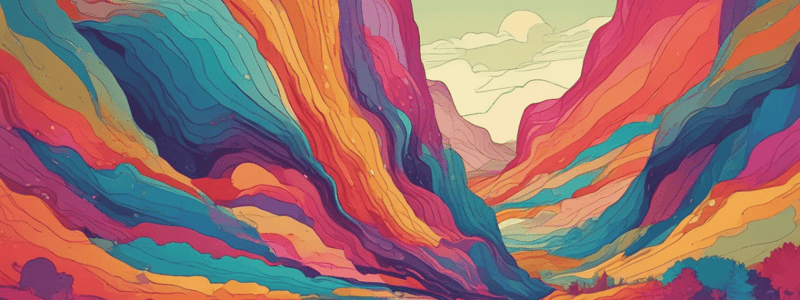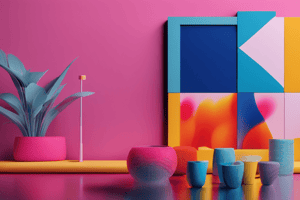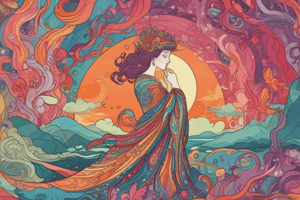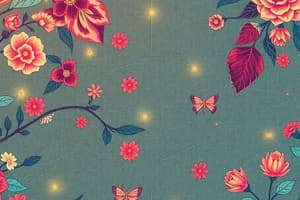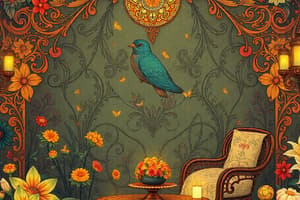Podcast
Questions and Answers
What is the foundation of color mixing?
What is the foundation of color mixing?
- Tertiary colors
- Primary colors (correct)
- Secondary colors
- Color values
What is the result of mixing red and blue?
What is the result of mixing red and blue?
- Orange
- Green
- Purple (correct)
- Yellow
What is the term for the lightness or darkness of a color?
What is the term for the lightness or darkness of a color?
- Hue
- Color temperature
- Saturation
- Color value (correct)
What is the effect of adding black to a color?
What is the effect of adding black to a color?
What is the characteristic of warm colors?
What is the characteristic of warm colors?
What is the purpose of understanding color temperature?
What is the purpose of understanding color temperature?
What is the result of mixing a primary color and its adjacent secondary color?
What is the result of mixing a primary color and its adjacent secondary color?
What is the basic technique of mixing colors on a palette or canvas?
What is the basic technique of mixing colors on a palette or canvas?
What is the technique that involves layering and gradually mixing colors together?
What is the technique that involves layering and gradually mixing colors together?
What is the technique that adds depth and richness to your artwork by layering transparent or translucent colors over a dried base layer?
What is the technique that adds depth and richness to your artwork by layering transparent or translucent colors over a dried base layer?
What is the technique that involves applying wet paint onto a wet surface?
What is the technique that involves applying wet paint onto a wet surface?
What is the technique that involves lightly brushing a different color over a base layer?
What is the technique that involves lightly brushing a different color over a base layer?
What is the technique that involves diluting colors with water and applying them in a transparent, flowing manner?
What is the technique that involves diluting colors with water and applying them in a transparent, flowing manner?
What is the term for the distribution of colors within an artwork?
What is the term for the distribution of colors within an artwork?
What are colors that sit opposite each other on the color wheel called?
What are colors that sit opposite each other on the color wheel called?
What is the term for the lightness or darkness of a color?
What is the term for the lightness or darkness of a color?
What is the term for the process of creating a visually striking and balanced composition by using complementary colors?
What is the term for the process of creating a visually striking and balanced composition by using complementary colors?
What is the term for the process of creating a sense of harmony and balance by using analogous colors?
What is the term for the process of creating a sense of harmony and balance by using analogous colors?
What is the primary effect of utilizing a wide range of values in your artwork?
What is the primary effect of utilizing a wide range of values in your artwork?
What is the term for contrasting different hues to create visual impact?
What is the term for contrasting different hues to create visual impact?
What can be achieved by using complementary or contrasting colors on the color wheel?
What can be achieved by using complementary or contrasting colors on the color wheel?
What is the purpose of texture contrast in an artwork?
What is the purpose of texture contrast in an artwork?
What can be achieved by varying the size and shape of elements in an artwork?
What can be achieved by varying the size and shape of elements in an artwork?
What is the role of color theory in creating compelling visual art?
What is the role of color theory in creating compelling visual art?
What is the term for the visually pleasing arrangement of colors in an artwork?
What is the term for the visually pleasing arrangement of colors in an artwork?
What is the purpose of using contrasting colors to create focal points?
What is the purpose of using contrasting colors to create focal points?
What is the effect of using saturated colors in contrast with desaturated colors?
What is the effect of using saturated colors in contrast with desaturated colors?
What is the purpose of considering the size and placement of color elements?
What is the purpose of considering the size and placement of color elements?
What type of colors create strong contrast and can be used to signify conflict or tension in a narrative?
What type of colors create strong contrast and can be used to signify conflict or tension in a narrative?
What is the effect of warm colors on the viewer's eye?
What is the effect of warm colors on the viewer's eye?
What is the effect of cool colors on the viewer's eye?
What is the effect of cool colors on the viewer's eye?
What is the purpose of using high-intensity colors in an artwork?
What is the purpose of using high-intensity colors in an artwork?
Which of the following attracts more attention in an artwork?
Which of the following attracts more attention in an artwork?
What is the result of combining color temperature, intensity, and harmony in an artwork?
What is the result of combining color temperature, intensity, and harmony in an artwork?
What is the role of color in visual art storytelling?
What is the role of color in visual art storytelling?
What does manipulating the intensity of colors create in an artwork?
What does manipulating the intensity of colors create in an artwork?
What is the purpose of using analogous colors in an artwork?
What is the purpose of using analogous colors in an artwork?
What is the purpose of a dominant color in an artwork?
What is the purpose of a dominant color in an artwork?
What is the result of deliberately selecting colors in an artwork?
What is the result of deliberately selecting colors in an artwork?
Why are neutral colors used in an artwork?
Why are neutral colors used in an artwork?
What is the effect of warm colors in an artwork?
What is the effect of warm colors in an artwork?
What can be used to symbolize various concepts or ideas in art?
What can be used to symbolize various concepts or ideas in art?
What can artists use to evoke specific emotions in their audience?
What can artists use to evoke specific emotions in their audience?
What refers to combinations of colors that work well together and create visual unity?
What refers to combinations of colors that work well together and create visual unity?
What is essential for effectively guiding the viewer's eye through an artwork?
What is essential for effectively guiding the viewer's eye through an artwork?
What should artists do to develop their unique style?
What should artists do to develop their unique style?
Flashcards are hidden until you start studying
Study Notes
Understanding Color Mixing Techniques
- The foundation of color mixing lies in the use of primary colors: red, blue, and yellow.
- Secondary colors are created by mixing equal parts of two primary colors:
- Red and blue make purple
- Blue and yellow make green
- Yellow and red make orange
- Tertiary colors are achieved by mixing equal parts of a primary color and its adjacent secondary color:
- Red-orange, yellow-orange, yellow-green, blue-green, blue-violet, and red-violet
- Color values refer to the lightness or darkness of a color:
- Adding black creates a shade
- Adding white creates a tint
- Color temperature can evoke different emotions and moods:
- Warm colors (red, orange, and yellow) create energy and excitement
- Cool colors (blue, green, and purple) evoke calmness and tranquility
Color Mixing Techniques
- Direct Mixing: combining two or more colors to create new hues
- Blending: smoothly transitioning from one color to another
- Glazing: layering transparent or translucent colors over a dried base layer
- Wet-on-wet: applying wet paint onto a wet surface
- Scumbling: lightly brushing a different color over a base layer
- Color Washes: diluting colors with water and applying them transparently
Color Balance and Contrast
- Color balance refers to the distribution of colors within an artwork
- Techniques for achieving color balance:
- Using complementary colors
- Using analogous colors
- Assigning dominance to one color while making others subordinate
- Contrast can be created through:
- Value contrast: using a wide range of light and dark values
- Hue contrast: using contrasting colors
- Texture contrast: combining smooth and rough textures
- Size and shape contrast: using varying sizes and shapes
Color in Composition and Focal Points
- Color harmony refers to the visually pleasing arrangement of colors in an artwork
- Creating focal points using color:
- Contrast: using contrasting colors to make areas stand out
- Saturation: using saturated colors to draw attention
- Size and placement: strategically placing color elements to create focal points
- Color intensity: using bright or muted colors to create visual interest
- Balancing color in composition:
- Choosing a dominant color
- Selecting subordinate colors to complement the dominant color
- Using neutral colors to provide visual breaks
- Considering color temperature to create depth and balance
Using Color as a Storytelling Element
- Color symbolism: using colors to represent concepts or ideas in art
- Color psychology: using colors to evoke specific emotions or responses
- Color harmonies: using color combinations to create a sense of unity and visual harmony
- Color temperature: using warm and cool colors to create depth and atmosphere
- Color intensity: using bright or muted colors to create visual interest
- Color as a narrative element: using color to tell a story and convey meaning in visual art
Studying That Suits You
Use AI to generate personalized quizzes and flashcards to suit your learning preferences.
